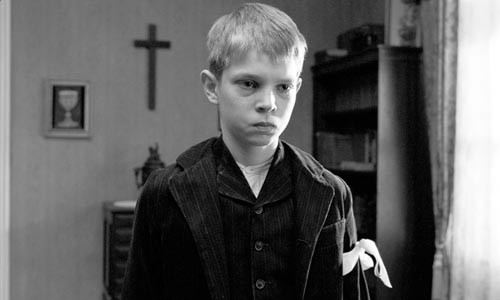Michael Haneke's The White Ribbon comes to us with a pedigree: the Palme D'Or at Cannes, an Oscar nomination, and literally a world of praise, not to mention the author's reputation, which is superlative and well deserved. It's an austere and beautiful work, and something of a puzzle film, but not like his earlier Caché. What is this all about? What is Haneke up to?
A lot, of course, some of it glisteningly clear, some of it more recondite than it needs to be. Caché was a film about the complexities and ambiguities of modern life, so its unresolved story made sense. The White Ribbon is, in many ways, a film about the moment when modern life turned so complex and ambiguous, and its conclusion isn't really as fuzzy as it seems.
Haneke's drama, which he filmed in black and white, and without a musical score, follows a year in the life of a village in northern Germany, although we don't know it opens in 1913 until the last half hour. And yet, as the moment of Archduke Ferdinand's assassination approaches, and the narrator -- the town's 31-year-old school teacher, recalling the past from old age -- presages terrible things about to happen, world war is not really what he's talking about.
Then again, yes it is. As always with Haneke, meaning is fluid and story is allegory -- or perhaps in this case parable, given its Grimm sensations. The town in which the teacher lives revolves largely around the well-landed Baron, who employs half of its citizens. His wife, the Baroness, is dissatisfied, and his mop-haired son is sullen and bored. The town's doctor lost his wife four years earlier during childbirth, and the town's buttoned-up midwife has helped him raise the child. The two are having sex, albeit quickly: standing up and from behind, fully clothed, or just a hand job, during which, one day, the doctor tells her that she repels him, and their affair is over. He also takes whatever pleasure he likes from his teen-age daughter.
There's a town pastor with many children, and when two of them run off to play and come home late for dinner, frightening the family, he berates them for their insensitivity. Then he sends the entire family -- including himself and his wife -- to bed without supper, with a promise of a whipping in the morning. The two children who ran off must also wear white ribbons because white represents purity and innocence, virtues of which they need to be constantly reminded.
This would all be enough for a drama: a slice of life, specific to a time and place, presented through the icy lens of a director who's clearly a profound and troubled humanist. But there's more going on. The doctor is out riding one day, and when the horse falls, the doctor breaks his arm. Someone has strung a trip wire across his field. The Baron's son disappears for a few hours, and they find him alive in a barn, hanging by his feet, his pants pulled down, his bottom reddened from a beating. Then, someone kidnaps the midwife's retarded child, and when they find him alive, his face has been bloodied and scarred. Who's doing these things, and why?
By the time it's over, it doesn't matter too much, for Haneke has made his point: Our crystallizing century, he says, will become one of seemingly random brutality, and it's not just confined to the adults. Somehow, this disease of humankind has infected our children. Does our warring society incite our individual behavior, or is it the other way around?
In his earlier films -- like The Piano Teacher or Funny Games -- Haneke never flinched at showing us the graphic sex and violence (sometimes together, sometimes not) that polluted psyches and fueled our treatment of one another. In The White Ribbon, he spares us the most graphic details: We see a dead woman in bed only from the knees down, and the most brutal things that happen to the children happen off camera (although a lot of adolescent faces get roundly slapped). Was he sparing his young actors, or his audience?
In his narration, the school teacher prepares us for upcoming turns of the plot. He warns of the "horror and perplexity" of what happens after the joyful fall harvest festival, and as 1914 dawns, we're told of "a radical change we couldn't foresee." In case we didn't get it, we're reminded at the end to deplore this pseudo-religious culture, so lacking in warmth and compassion, so far from the teachings of Christ, with a predilection for malice, envy, apathy and brutality, especially from its men, and now, from its emerging generation.
There's a teen-age blond girl who lashes out at her strict father by putting a pair of scissors through the skull of his beloved parakeet and leaving it on his desk for him to find. She made me think of the malevolent little Polish girl in Schindler's List who shrieks "Goodbye, Jews!" as the police take her neighbors away to their final destination.
And yet, The White Ribbon neither moved nor puzzled nor disturbed me. Perhaps I already expected this sort of behavior from early 20th-century rural Teutonic descendents of Martin Luther. (That's a mouthful, but then, so is German.) Or perhaps, this time, Haneke desired a more reserved contemplation of his themes. If you've never seen a Haneke film, The White Ribbon isn't the best place to start. And if you have, this will have to do for now. In German, with subtitles.

Starts Fri., Feb. 26. Regent Square















